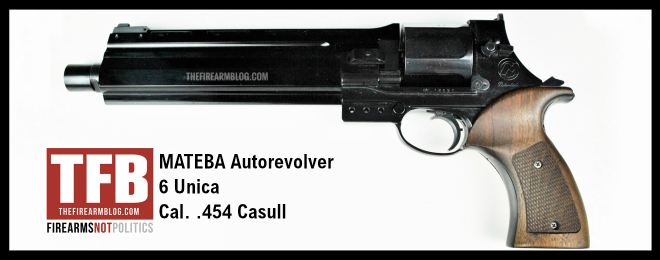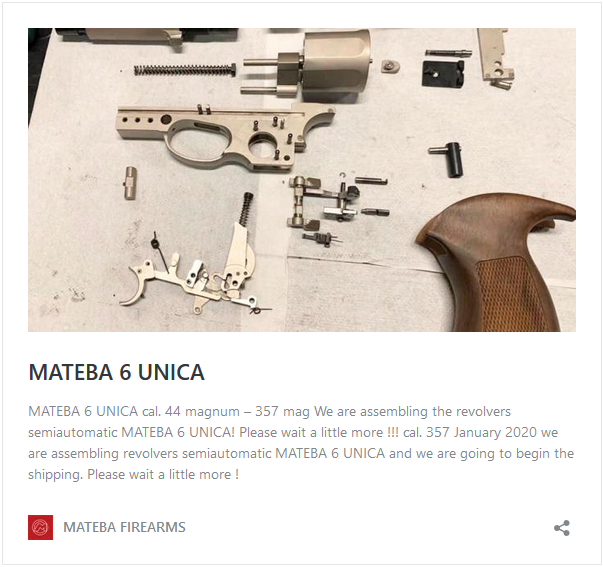The MATEBA Autorevolver, thanks to some media exposure, uniqueness and limited availability, has gained a cult status among firearm enthusiasts. In the anticipation of hopefully seeing newly manufactured models on the market, here we get the chance to have a close look at one “vintage” piece in the most powerful caliber.
MATEBA Autorevolver 6 Unica cal. .454 Casull – A Close Look – Table of Contents:
- Intro
- Semiautomatic Revolvers
- Company Background
- Overview and Specs
- Peculiarities
- Open Top Frame
- Low Bore Axis
- Removable Barrel
- Grip
- Sights
- Semiautomatic Operation
- Field Strip
- Range Feedback
- Handling
- Trigger Pull
- Springs
- Range Anecdotes
- Pros & Cons
- Final Considerations
- TL-DR
1. MATEBA Autorevolver 6 Unica cal. .454 Casull – Intro
A disclaimer first.
I usually try to write TFB articles with a rather impersonal approach, but this one is going to have a very personal influence. This is because I’m not reviewing a loaner firearm that I like and I may purchase as a result. I’m presenting you the firearm I bought as soon as I legally could, back in 2003. I’m no longer its official owner as I’m leaving abroad, but thanks to the help of friends and relatives it’s still in the family. And there it will stay. I’ll try to be as objective as possible but I may show some bias here and there. Please bear with it.
Now, I’m about to start the review of a rather obscure, somewhat unsuccessful, yet fascinating firearm. I may need some spiritual guidance through this endeavor…

MATEBA Autorevolver 6 Unica cal. .454 Casull – A divine source of Inspiration. Poster available for purchase here.
OK. With this in place, I can now have the confidence to walk you through this journey. We’ll start with a quick look at other semi-auto revolvers, we’ll introduce the company Mateba and then we’ll look closely at my 6 Unica.
I’ll be going “full nerd” on some details, if you are just here for the photos, there’s a TL-DR section at the end. And then you can insult me in the comments.
2. MATEBA Autorevolver 6 Unica cal. .454 Casull – Semiautomatic Revolvers
The world of these hybrid handguns is definitely small. Theoretically, they offer the advantages of both revolvers and semiautomatic pistols, however, they risk to have the drawbacks of both platforms. The limited adoption of the concept by designers and manufacturers proves that users do not really feel the need for semiautomatic revolvers.
Indeed the Mateba Autorevolver is the latest and likely the last of this breed. The first, and most famous, example is the British Webley–Fosbery Self-Cocking Automatic Revolver. This handgun, designed with the intent of making it a military issue, which never happened, was manufactured in the first quarter of the 20th Century by Webley & Scott.
In this video from Forgotten Weapons, you can see it in operation. We can see that the cylinder is part of an upper frame which slides within the lower frame, holding grip, trigger and manual safety lever. This SA only revolver upon recoil, through the movement of the slide, re-cocks the hammer and partially rotates the cylinder. The return to the battery under the force of a spring completes the rotation aligning the top chamber of the cylinder to the forcing cone of the barrel. The revolver is then ready for another SA shot.
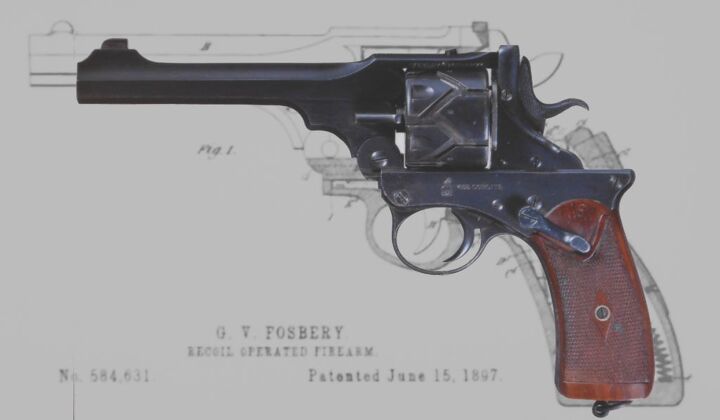
MATEBA Autorevolver 6 Unica cal. .454 Casull – Webley-Fosbery Self-Cocking Automatic Revolver cal .455 Webley. – Image Credit: Wikipedia.
Another firearm adopting a system similar to the Webley-Fosbery is the American Union Automatic Revolver (thanks ostiariusalpha for letting me know about it). The most obvious difference, besides the size, is the fact that the grip frame extends upward to protect the hand of the shooter from painful “slide bites”. The patent on this rare and unsuccessful revolver can be found here.
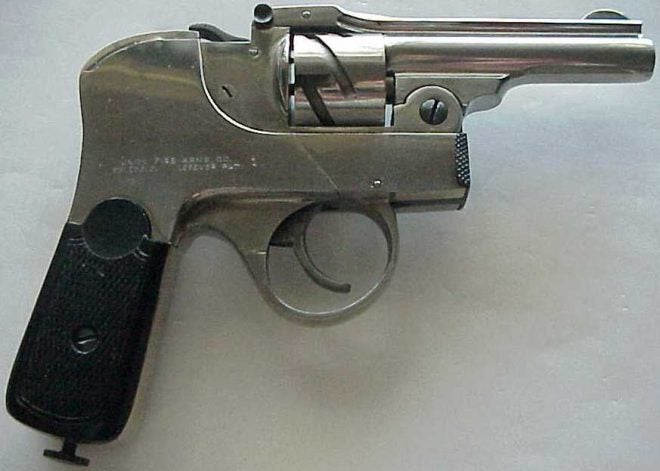
MATEBA Autorevolver 6 Unica cal. .454 Casull – Union Automatic Revolver cal. .32 S&W. – Image Credit: Wikipedia.
To my knowledge, these two are the only semi-automatic revolvers which actually reached production other than the 6 Unica. We’ll see in a while how these relate to the Mateba Autorevolver.
3. MATEBA Autorevolver 6 Unica cal. .454 Casull – Company Background
Ma.Te.Ba. was founded in Pavia, Italy, by the designer Emilio Ghisoni out of an unrelated family business. The name comes from “MAcchine TErmo BAlistiche” which means Thermo-Ballistic Machines, an oddly verbose way to say “firearms”. This peculiar choice of name perhaps is an early indication of the out of the box approach that Ghisoni put in all of his designs.
While under Ghisoni Mateba also manufactured a semi-automatic target pistol, it’s his re-designing of what a revolver is which gave some notoriety to the company.
The less known design, possibly the one more difficult to be identified as a revolver at a glance, is the MTR. This double action revolver places the cylinder in front of the trigger, sacrificing barrel length per a given OAL, but drastically lowering the bore axis. Most likely the front-heavy design is further helping in minimizing barrel flip in this target pistol. Having the cylinder in that position allowed the use of wider diameter cylinders, ranging from 8 .38 Special / .357 Magnum rounds to 14 .22 LR, to be loaded through special moon clips.
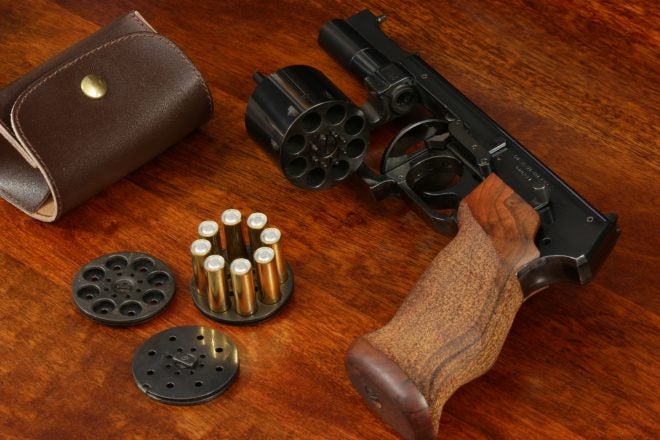
MATEBA Autorevolver 6 Unica cal. .454 Casull – Mateba MTR-8, cal. .38 Special. – Image Credit: Wikipedia.
Still aiming to lower the bore axis, but moving towards a more conventional form factor, Ghisoni designed the 2006M. This wheelgun introduces one element which will always be associated with Mateba and Ghisoni: the low barrel aligned to the bottom chamber of the cylinder. Other peculiarities of the model, chambered in .357 Magnum, are the cylinder yoke opening upwards and the short OAL relative to the barrel. While the main focus was still on target shooting, the interchangeable barrels (up to 9 different lengths) could allow a wider range of uses.

MATEBA Autorevolver 6 Unica cal. .454 Casull – Mateba Italia, modern production, 2006M snubnose revolver cal. .357 Magnum. Noe the interchangeable barrel shroud with different finish compared to the frame.
The 6 Unica (reads as “You’re Unique” in Italian) .357 Magnum, also known as Autorevolver, is the last model manufactured by Ghisoni’s Mateba. While here we’ll see a .454 Casull piece, the designer only fathered the .357 model (here is the patent). A quick chat with the late Ghisoni in 2006 (the year, not the handgun) highlighted the fact that he was not satisfied with the deal gotten when he sold Mateba (in the early 2000s), nor happy with the direction taken by the company. The Grifone carbine based on the 6 Unica, in .357 Magnum, is likely to be the last product of this series he oversaw.
In the post-Ghisoni period, besides scaling up to .44 Magnum and .454 Casull (and prototyping the .41 Magnum model), Mateba also manufactured 1911 copies and lever-action rifles. Apparently, however, moving to more popular models was not enough to prevent bankruptcy, around 2005.
The Mateba name was in more recent years bought by investors willing to revive the original product lines, together with manufacturing/assembling AR-15 and precision rifles. Here below we can see a promising update from their website (dated January 2020) on the progress of re-manufacturing the 6 Unica.
4. MATEBA Autorevolver 6 Unica cal. .454 Casull – Overview and Specs
For an overview of what the Mateba Autorevolver is, I suggest watching the excellent video below from Youtuber LifeSizePotato. The gentleman behind the channel used to manage the website Matebafan.com dedicated to Ghisoni designs, but unfortunately, it is now offline.
Here are the general, official Specs from the manufacturer’s manual:
Model: Autorevolver “6 Unica ” or Rifle “Grifone”
Caliber: .357 M – .44 RM – .454 Casull
Barrel: interchangeable from 3″ to 9″ 1/2 for the revolver and from 18″ to 20″ for
the Rifle
Finishing: Blue or Nickel Plated Matte
Rear sight: fixed
Front sight: adjustable
Weight: from 2.6 lbs to 4.2 lbs for the revolver and from 5.3 lbs to 6.4 lbs for the
rifle
Thickness: 1.6 inch
Pistol grip: Selected French Walnut
Cylinder: 6 rounds — clockwise turning
Scope mount: available
Muzzle Compensator: available
Holster: available in 4″ and 6″
With regards to the actual firearm we are looking at, I took some measurements and I dug a bit online to have more accurate values.
All firearms sold in Italy, manufactured locally or imported, are (or maybe were up to a few years ago) required to be included in a National Catalog (yes, gun control). Some venues online, such as the website of the magazine Armi e Tiro, allow a direct search through this Catalog.
This model carries the Cat. no. 12691, you can see it in some photos stamped on the left side of the frame, just below the cylinder. Through this I discovered that the full official name of the model, although it does not appear anywhere else, is Autorevolver 6 Unica – Moser. My educated guess is that Moser just comes from MOttana SERgio, from the Mottana family who owned and managed Mateba after Ghisoni. The catalog also mentions that this specific revolver can legally be configured with barrels of three lengths: 8.5″, 9.5″ (as pictured here) and 10.15″. Buying a (serialized) barrel from another Cat. no. Autorevolver (say a 6″ .454 barrel) and assembling it on this frame would be technically possible but likely not legal, in Italy.
As far as I know these longer barrel lengths never reached the American market and they may have not been mass produced at all. I purchased my revolver directly from the factory with the 9.5″ installed. It may be sort of a production prototype as it shows a few unconventional features.
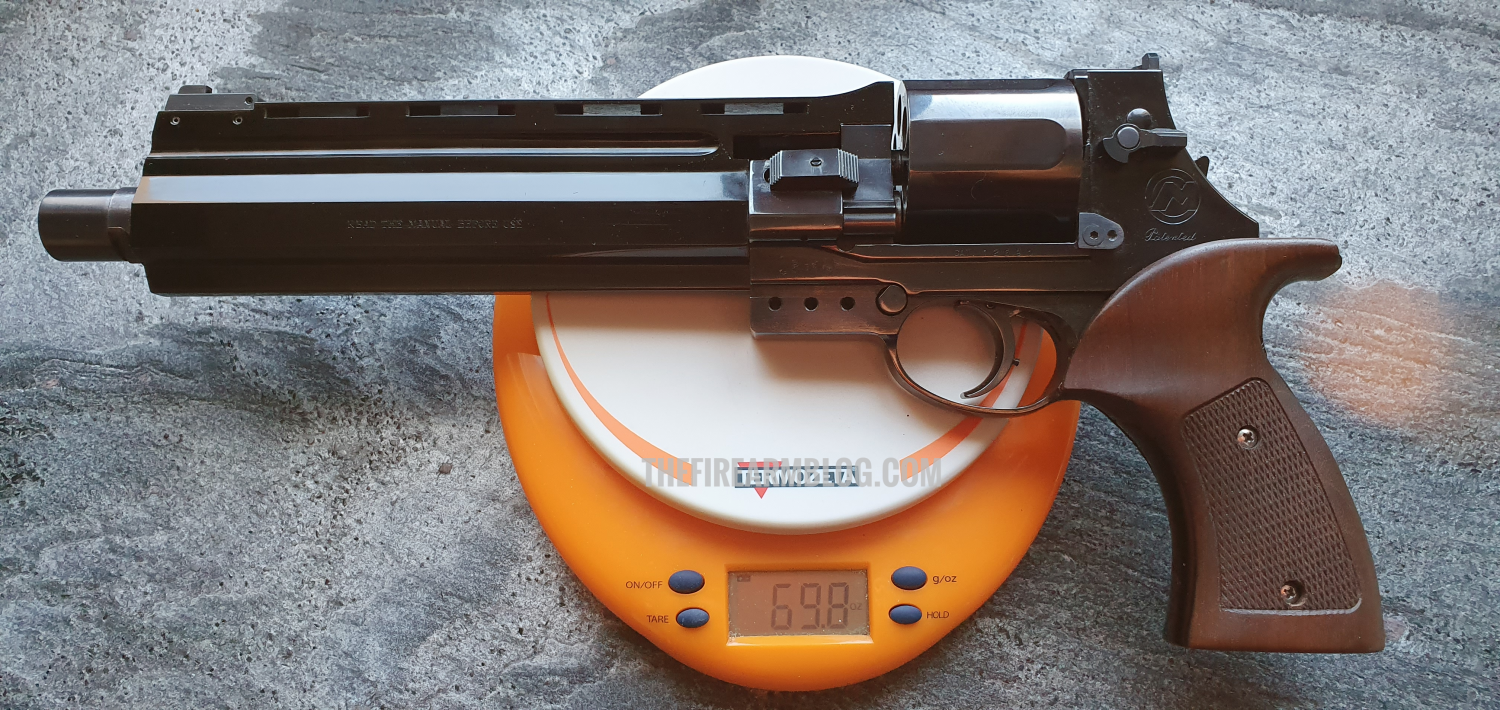
MATEBA Autorevolver 6 Unica cal. .454 Casull – About 4 lbs and 6 oz of steel, aluminum alloy and walnut wood. Or about 1.98 kg for those not from the USA or Liberia.
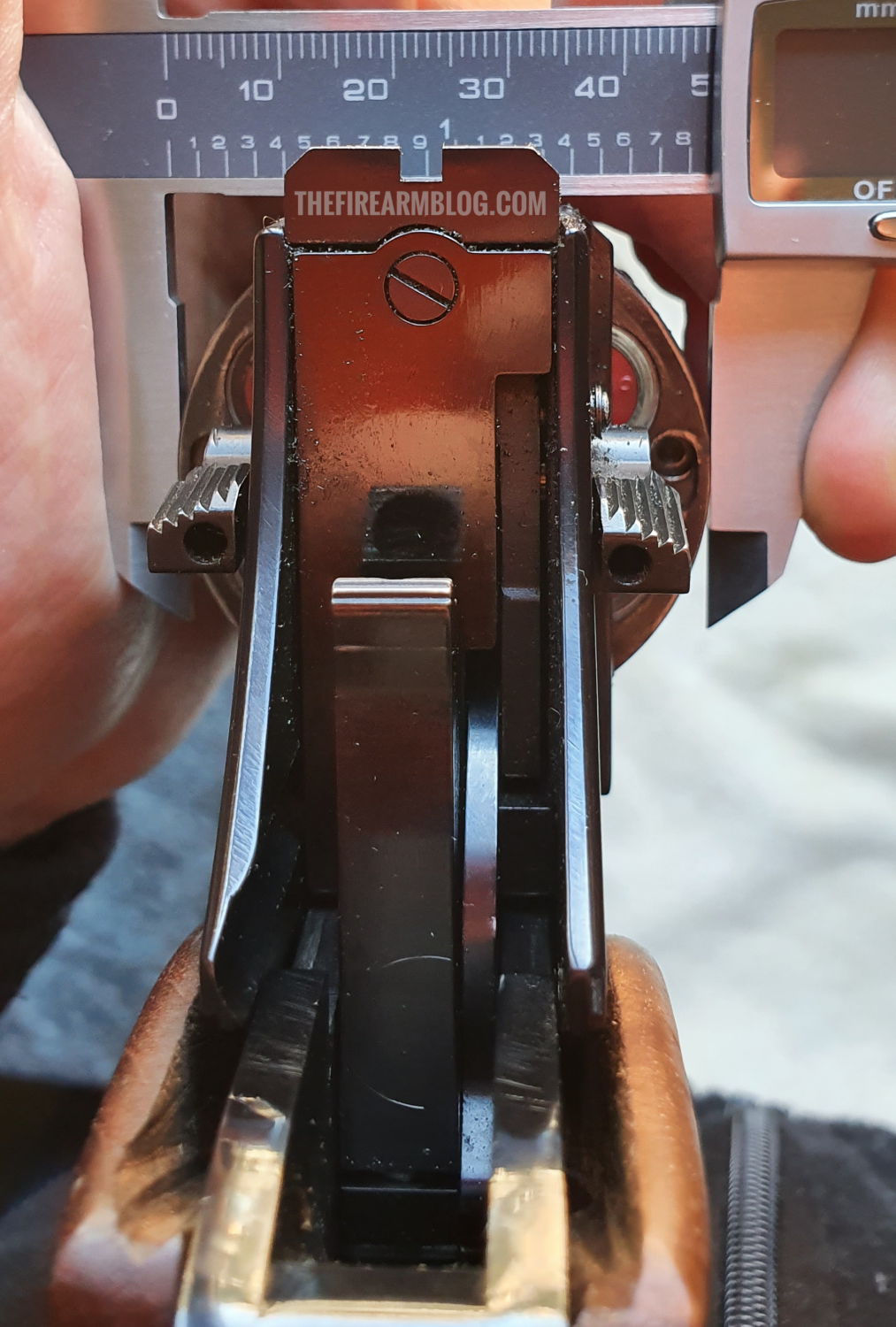
MATEBA Autorevolver 6 Unica cal. .454 Casull – Six rounds of high pressure .454 Casull require a beefy cylinder. The diameter is about 1.9″ (48mm). In the chambers you can see .45 Colt snap caps, because dry firing. You can notice the timing notches, on the cylinder face (between chambers) rather than weakening the side wall of the chamber as in most revolvers.
To summarize:
Model: Autorevolver “6 Unica ” – Moser
Caliber: .454 Casull
Barrel: 9″ 1/2 interchangeable with: 8″ 1/2 – 10″ 1/8
Finishing: blue
Rear sight: fixed
Front sight: adjustable
Weight: 4.4 lbs
Thickness: 1.9 inch
Pistol grip: Selected French Walnut – Aluminum alloy frame
Cylinder: 6 rounds — clockwise turning
Muzzle Compensator: available
5. MATEBA Autorevolver 6 Unica cal. .454 Casull – Peculiarities
We’ll look here at a few points worth discussing, either on the general Autorevolver design or on my piece. We’ll do with the help of some photos and the exploded diagram from the manual. We’ll get back to it as a reference quite a few times.
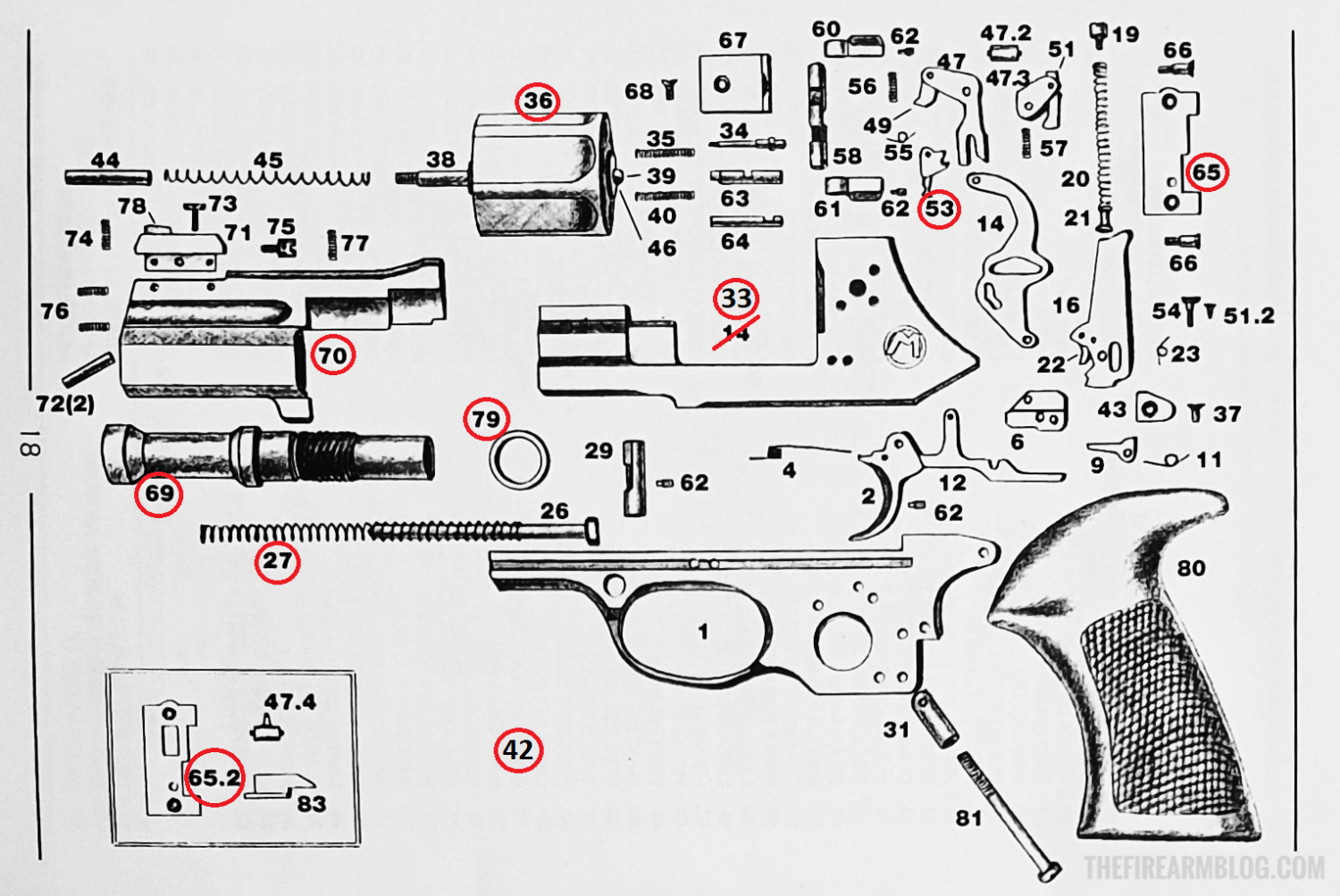
MATEBA Autorevolver 6 Unica cal. .454 Casull – Mateba Autorevolver exploded diagram. Circled numbers are the parts that according to the manual differ from caliber to caliber. No. 42 would be the cylinder yoke, absent in the drawing.
- Open Top Frame
This is a feature which may not be so obvious but in my opinion, deserves some attention. Open top frames such as in the Uberti replica of Colt Model 1851 Navy revolver below, were a common sight in the black powder, percussion era. This configuration however is no longer in use as not strong enough to hold up to the higher pressures of smokeless powder cartridges. At each shot sudden, opposing, forces on the upper part of the frame generate torque opening up the cylinder window. The top strap on modern revolvers allows for a more rigid frame, more capable of coping with these stresses, even when firing higher pressure rounds.
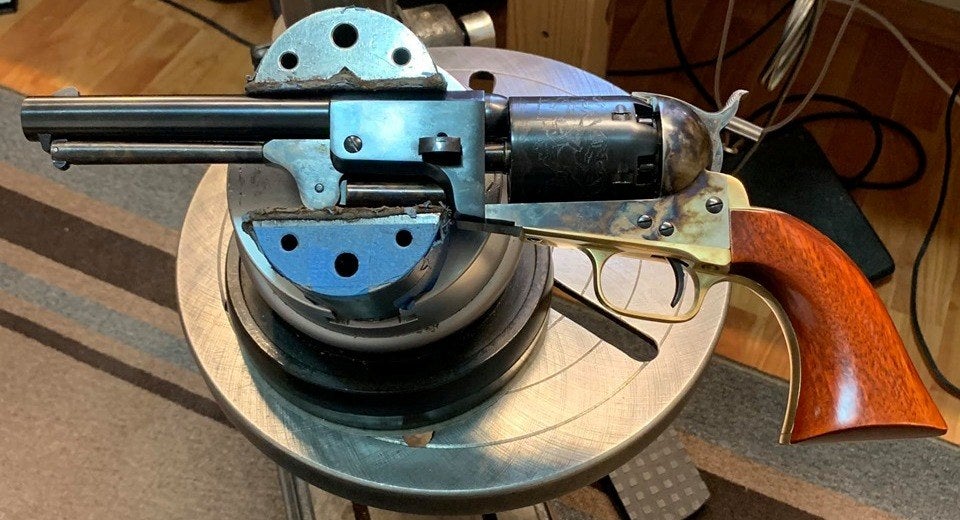
MATEBA Autorevolver 6 Unica cal. .454 Casull – Uberti replica of Colt Model 1851 Navy open top revolver. From the article Wheelgun Wednesday: Creating a Replica of Gustave Young Engraved Colt Dragoon Revolver.
So how is it possible that the Mateba Autorevolver can safely fire a 60,000 psi round through an open top frame?
This is an added benefit of the low barrel. By having the forces acting in the lower part of the frame, its top is not loaded, giving no need for additional reinforcement. So we have the most powerful open top revolver.
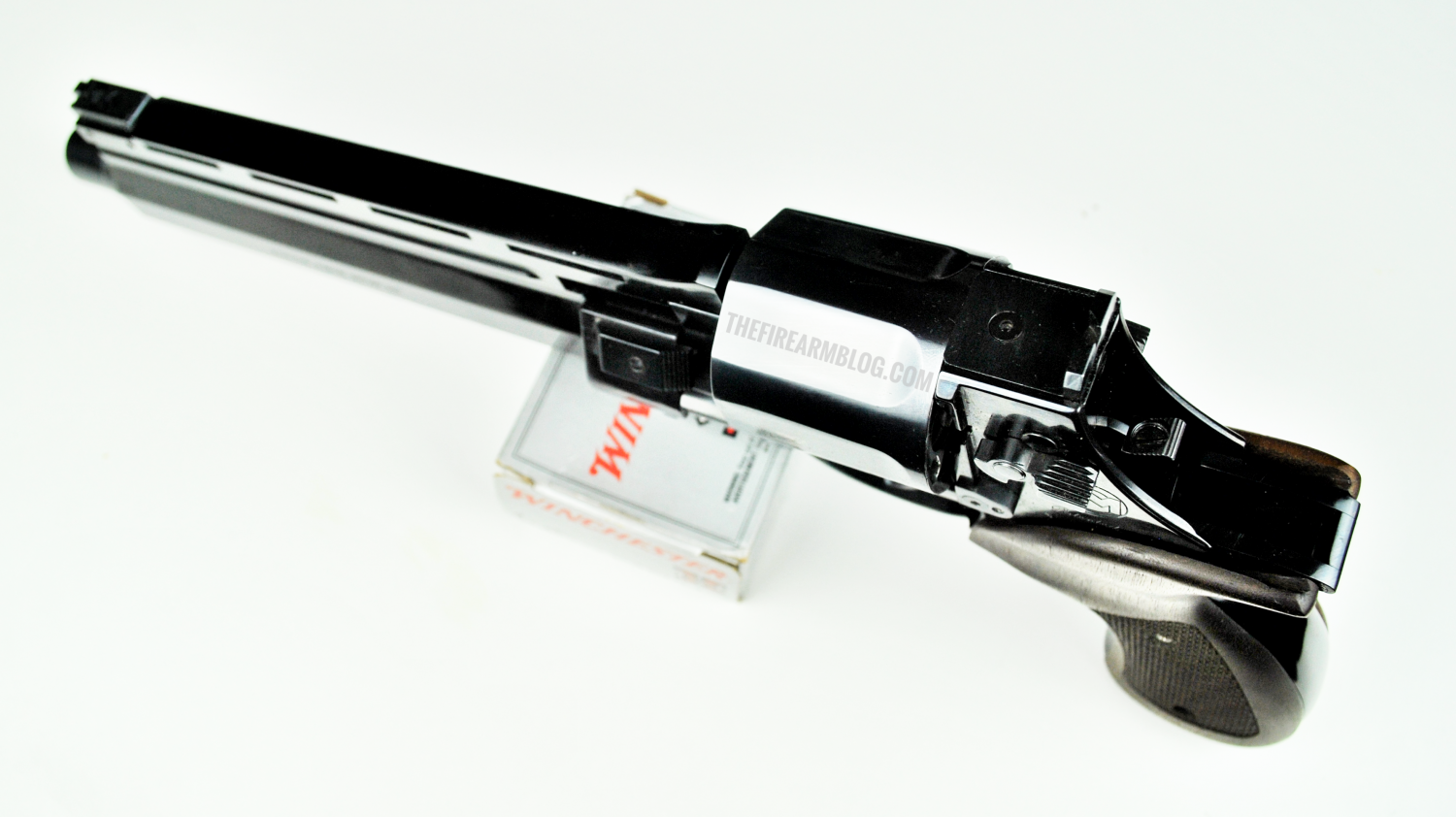
MATEBA Autorevolver 6 Unica cal. .454 Casull – View from the open top.
- Low Bore Axis
While there may have been revolvers sporting a low barrel, such as the Russian OTs-38, possibly developed before the Mateba 2006M, Ghisoni designs are mainly recognized for this feature. Certainly they made the low bore axis revolvers slightly more mainstream.
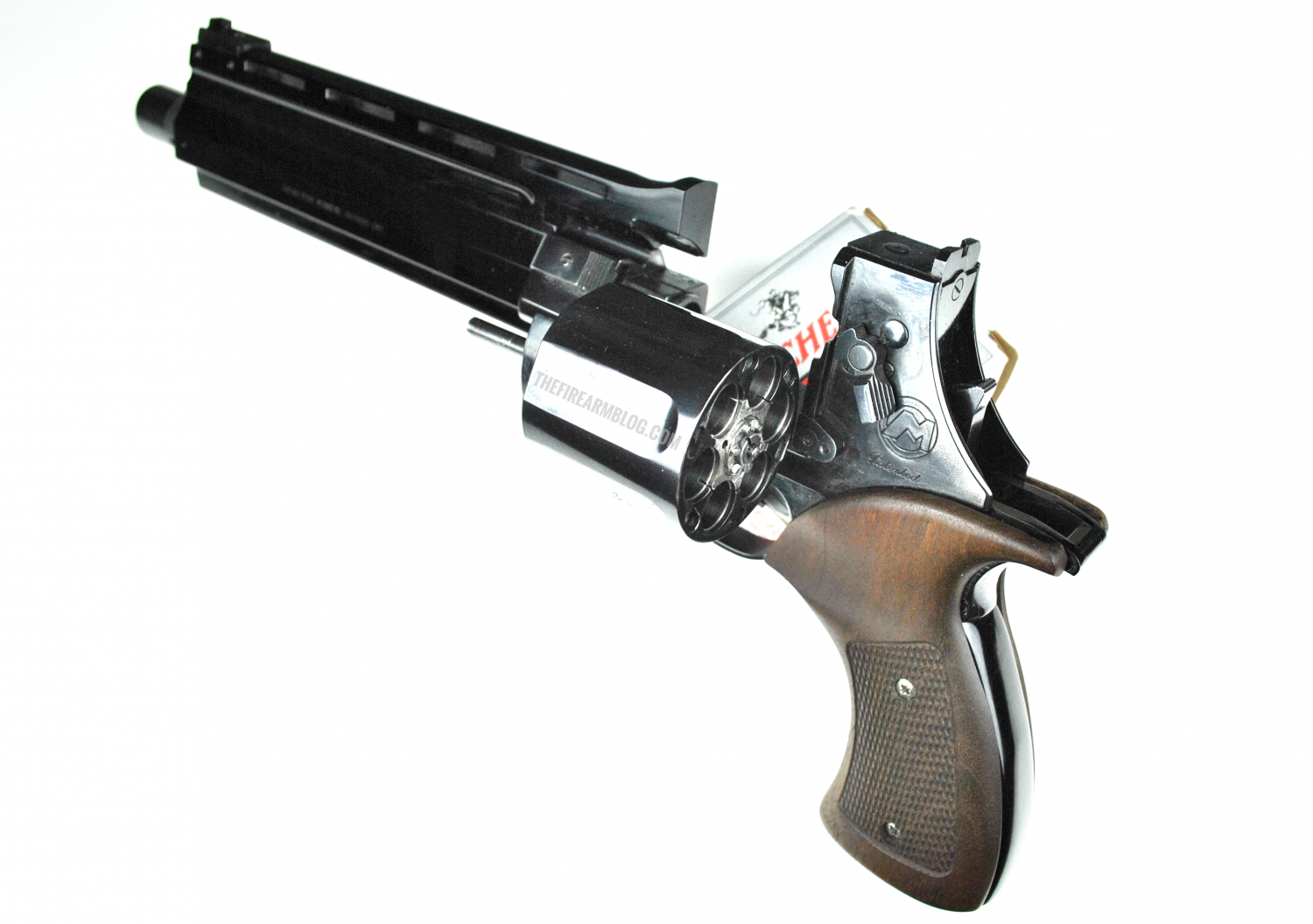
MATEBA Autorevolver 6 Unica cal. .454 Casull – Low barrel and counter-bored cylinder face.
The advantages of this configuration, and its drawbacks, are now well known. The low bore axis of the Autorevolver, coupled with the semiautomatic operation works well in producing a handgun pleasant to shoot.
- Removable Barrel
As mentioned the Mateba Autorevolver offers the possibility to change barrel lengths. The concept is not much different than what Dan Wesson offered decades ago. Differently from the American design, however, in this case there is no front tensioning nut, the barrel can be unscrewed by acting directly on its muzzle which extends from the barrel shroud. Unlike the .357 model, the bigger caliber versions do not require any special tool for barrel removal, a 5/8″ or 16mm spanner is sufficient.
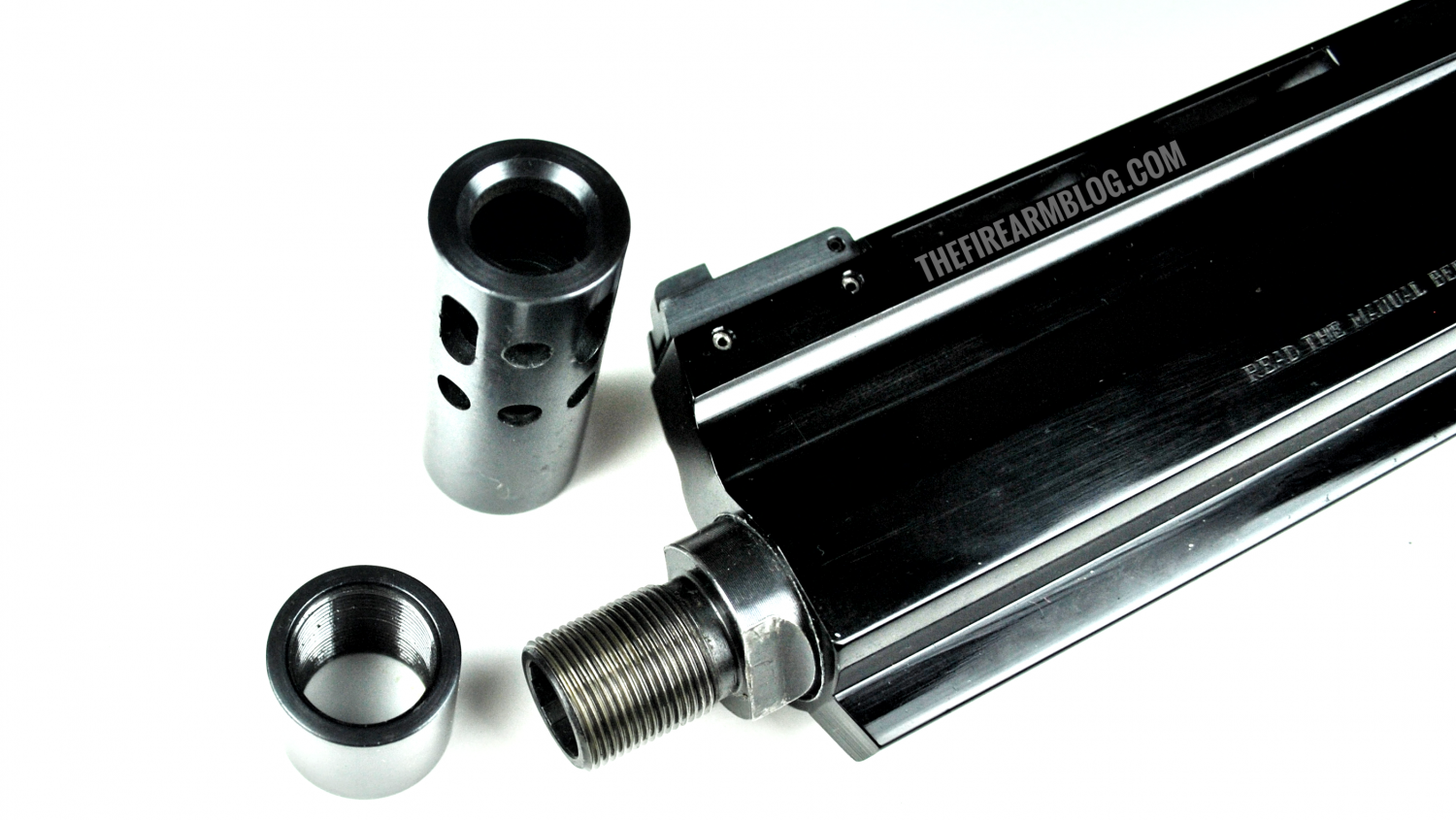
MATEBA Autorevolver 6 Unica cal. .454 Casull – Notches for barrel removal with a 5/8″ spanner. Threaded barrel to either accommodate the 6 holes compensator or the thread protector. Also note that the shroud of the barrel has a full-length underlug, usually it ends just in front of the frame, to hold in place the recoil spring guide rod.
- Grip
There is nothing that odd in the grip shape and configuration. We can just point out that, not unlike the Union Automatic Revolver, the grip provides suitable protection from slide bite. This is simply, and more elegantly, accomplished by the wood extending over the slide.
What’s worth pointing out is that the standard configuration is a monolithic French walnut piece held in place by a single threaded rod connecting it with the lower frame. This allows a certain freedom in the manufacturing of customized grips (Ghisoni made a few target shooting oriented variations) and it looks really neat. Below, in a photo from an older POTD, you can see this monolithic grip.
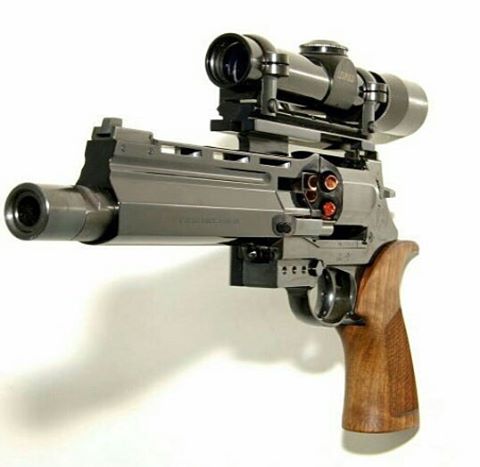
MATEBA Autorevolver 6 Unica cal. .454 Casull – Mateba Autorevolver 6 Unica with monolithic French walnut grip. The model can be recognized as a .44 Magnum due to the spanner notches on the barrel and the reinforced frame typical of the bigger calibers. The absence of a front lock on the cylinder yoke rules out the .454 Casull. Also note the use of the original Mateba scope mount, fastened on the right side to the 3 tapped holes on the front part of the lower frame.
This elegant solution however has drawbacks: as LifeSizePotato mentions, it can lead to cracking. Maybe to offset this tendency, the model in my possession was outfitted with an aluminum alloy frame covered by wood scales. The end result is not as clean looking, especially with the rather unglamorous button head Phillips screw, but it surely is stronger. This solution does not appear on any other photo I found online. Coupled with the rather rough machining on the flat sides, it makes me think this was a prototype.
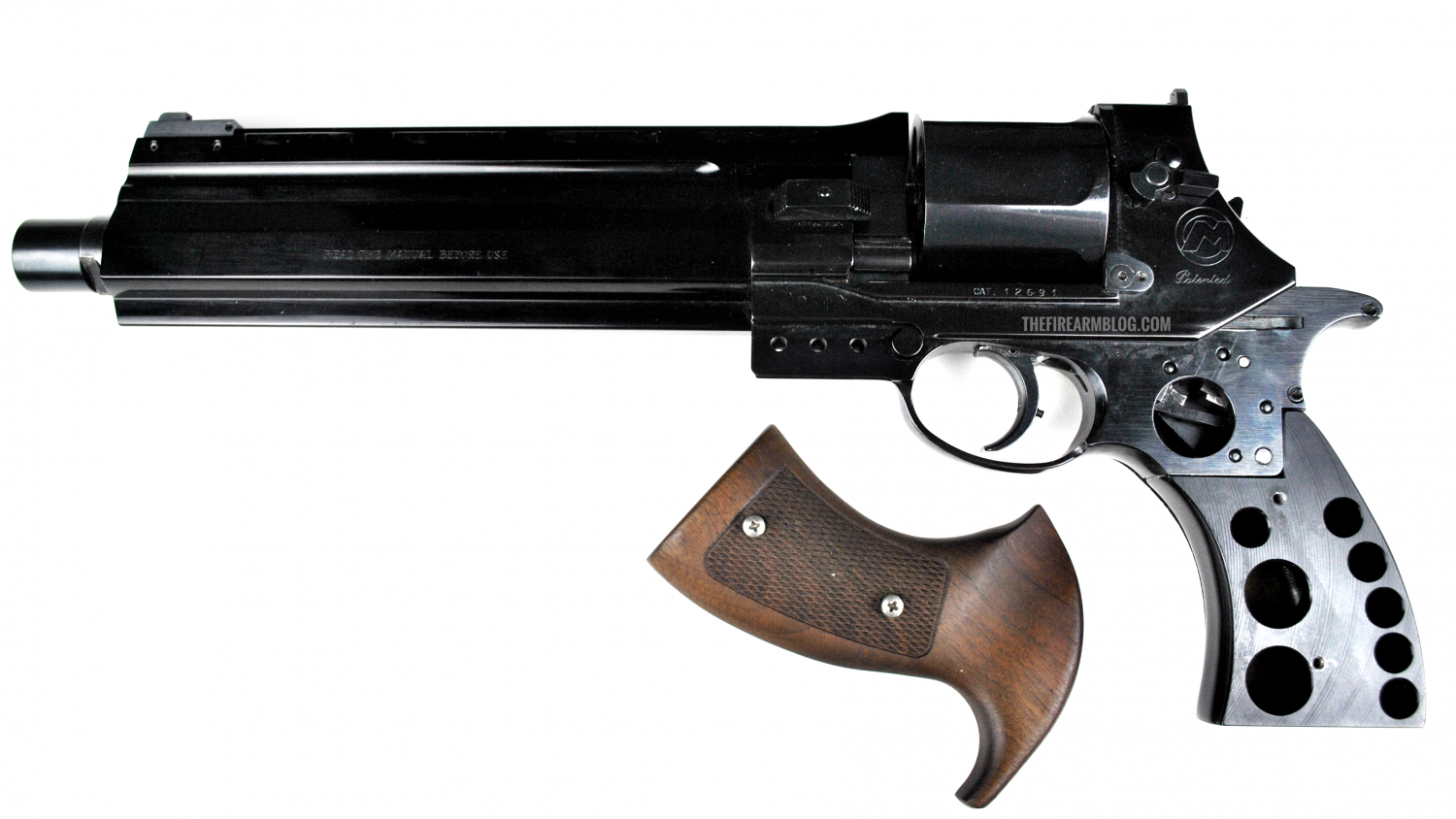
MATEBA Autorevolver 6 Unica cal. .454 Casull – Metal frame and wood scales offer a less pleasant yet stronger grip structure. Note also the front latch acting on the cylinder yoke. This, unlike Taurus’ solution with the same caliber, is not spring loaded, it must be closed manually.
- Sights
Sights are simple and efficient for the role they’ve been designed: target shooting. The front sight is a relatively small matte blue steel post with Patridge shape, a small dot is machined of the flat surface facing the shooter’s eye. The rear sight is a simple plate with a sharp notch. Online there are photos showing Autorevolvers with a similar configuration employing fiber optics, maybe more useful for hunting purpose.
The peculiarity here is that the rear sight is fixed, the front sight is adjustable in elevation and windage, as shown in the photo below. This, theoretically at least, allows each barrel to have its zero correctly set. The drawback is that the system is not compatible with anything available aftermarket.
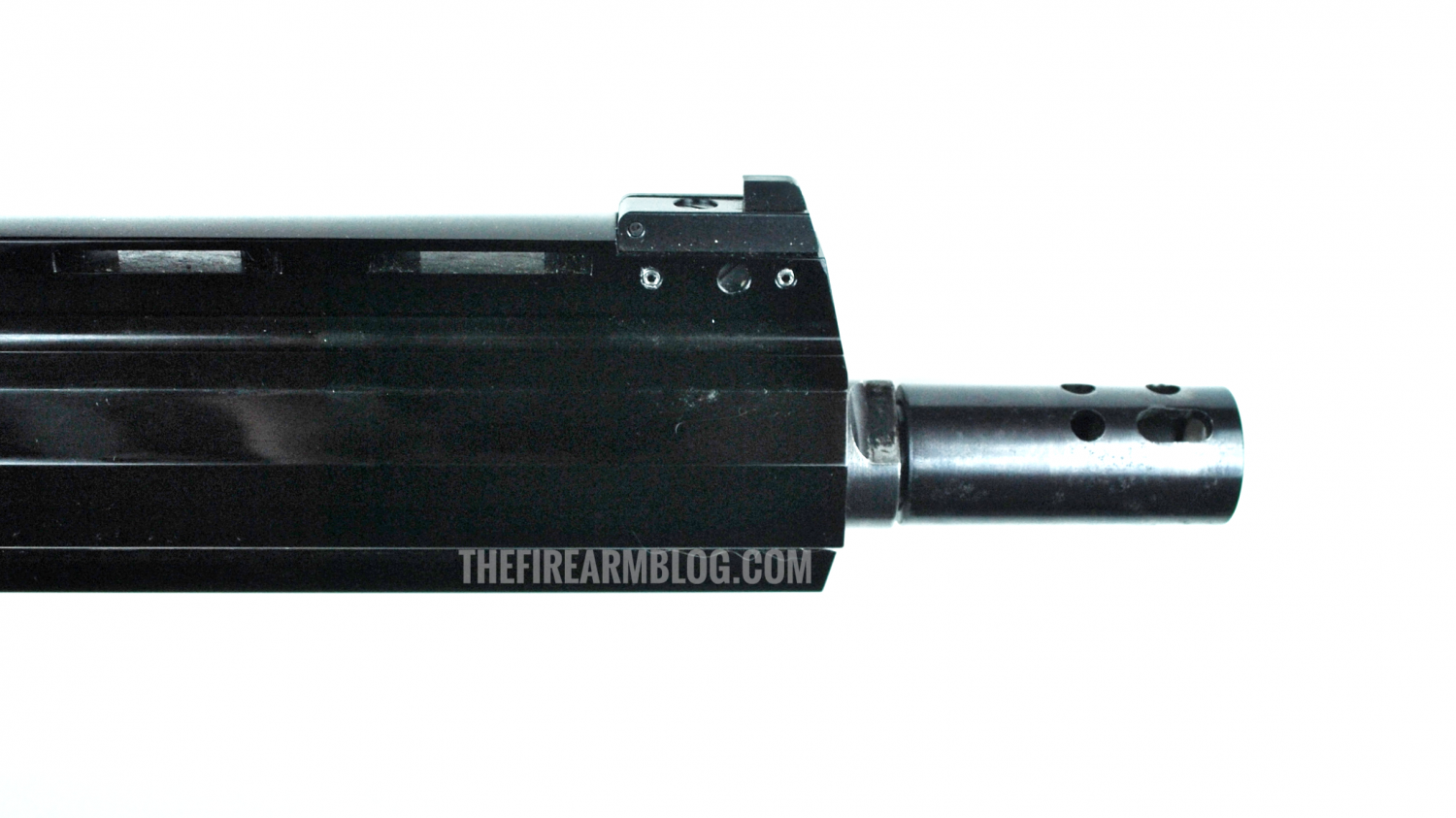
MATEBA Autorevolver 6 Unica cal. .454 Casull – Muzzle and front sight. The screw on the side, within assembly pins, controls the windage, the one on top the elevation. In this photo the 6 ports compensator is installed.
- Semiautomatic Operation
This is, of course, the main feature of the handgun. Just like for the Webley-Fosbery, the concept is simple: the recoil energy is used to cock the hammer and rotate the cylinder, allowing all shots after the first to be in SA. There are however a couple of differences with the British design.
First of all the Mateba Autorevolver can shoot in DA, while the Webley-Fosbery is a SAO revolver. Then, perhaps more importantly, the recoil motion (less than an inch) only cocks the hammer in the 6 Unica, the rotation of the cylinder happens entirely in the forward motion under the spring force. While the total energy required from the recoil for the cycle would be the same, keeping a more linear operation during the rearward motion may make the system less sensitive to grip strength and load power. This of course within a certain limit, as lower powered springs are required for non-Magnum loads.
How the cylinder rotation is accomplished is pretty cool, especially as the main leverages are exposed. Going back to exploded drawing, we can focus on items 14 and 47. The former is called “desmodromic” or “desmo”, it pivots on a pin in the lower frame and its motion is connected to the hammer. The latter, fork-shaped, is the “slide distributor” and it pivots on a pin in the top part of the upper frame. The two parts interconnect through a pin on the top of the desmo, the pin rides within the fork of the distributor. Cocking the hammer manually, or pulling the trigger in DA, moves back the desmo which in turn pulls the distributor, causing the rotation of the cylinder. Under recoil, there is no relative movement between the desmo and the distributor as both move rearward. The distributor is pulled when the desmo remains back and the slide moves forward, this again accomplishes the rotation.
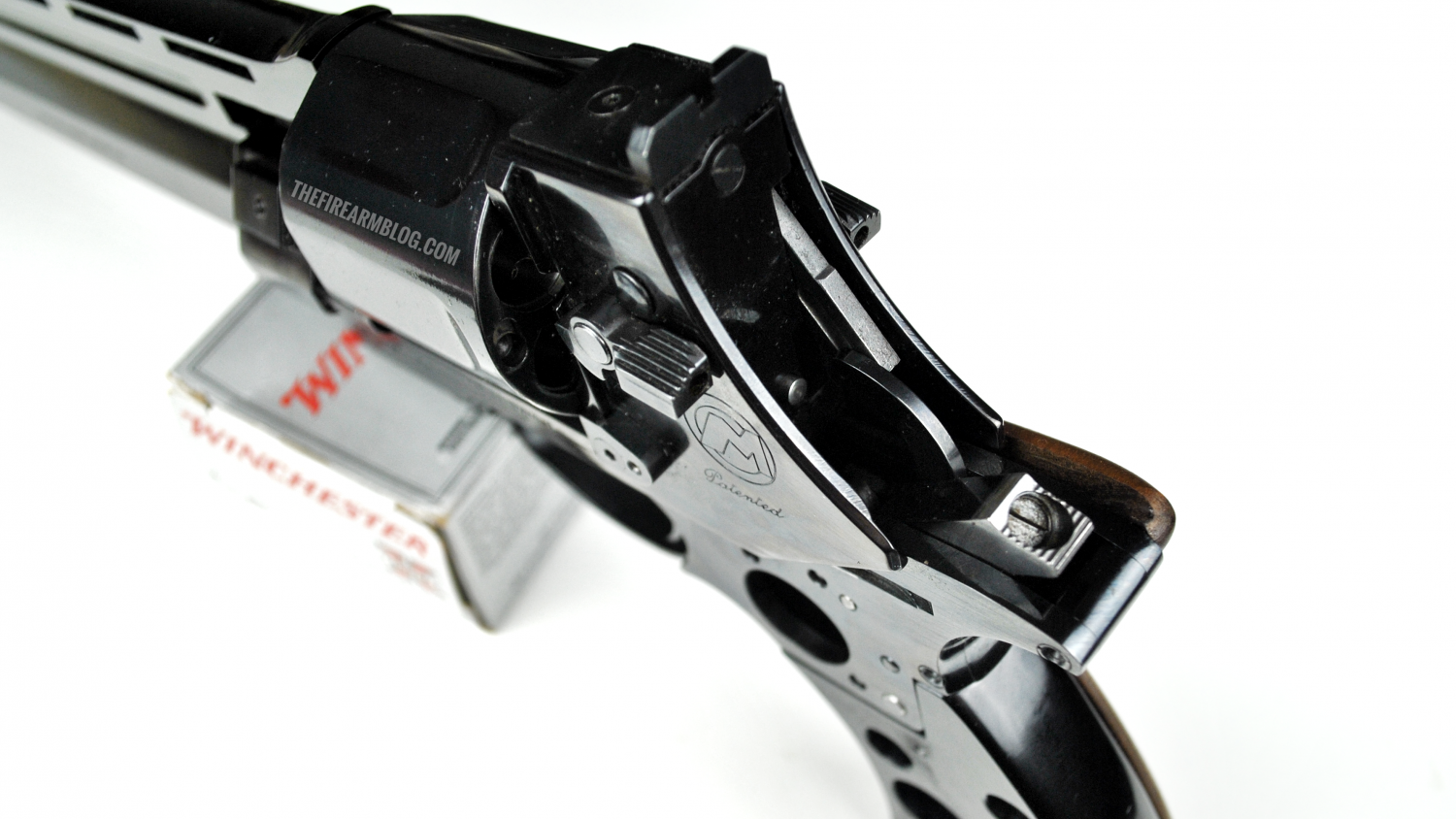
MATEBA Autorevolver 6 Unica cal. .454 Casull – Hammer cocked, to its right the “desmo”, linked to the distributor fork in its rearmost position.
6. MATEBA Autorevolver 6 Unica cal. .454 Casull – Field Strip
Since we touched a few mechanical details, it’s worth having a look at the field stripping technique of the firearm. We’ll see the procedure for separating the slide from the grip frame.
BEFORE YOU FIELD STRIP ANY WEAPON, REMEMBER the four rules of gun safety:
- All guns are always loaded.
- Never let the muzzle cover anything you are not willing to destroy.
- Keep your finger off the trigger until your sights are on the target.
- Be sure of your target and what is beyond it.
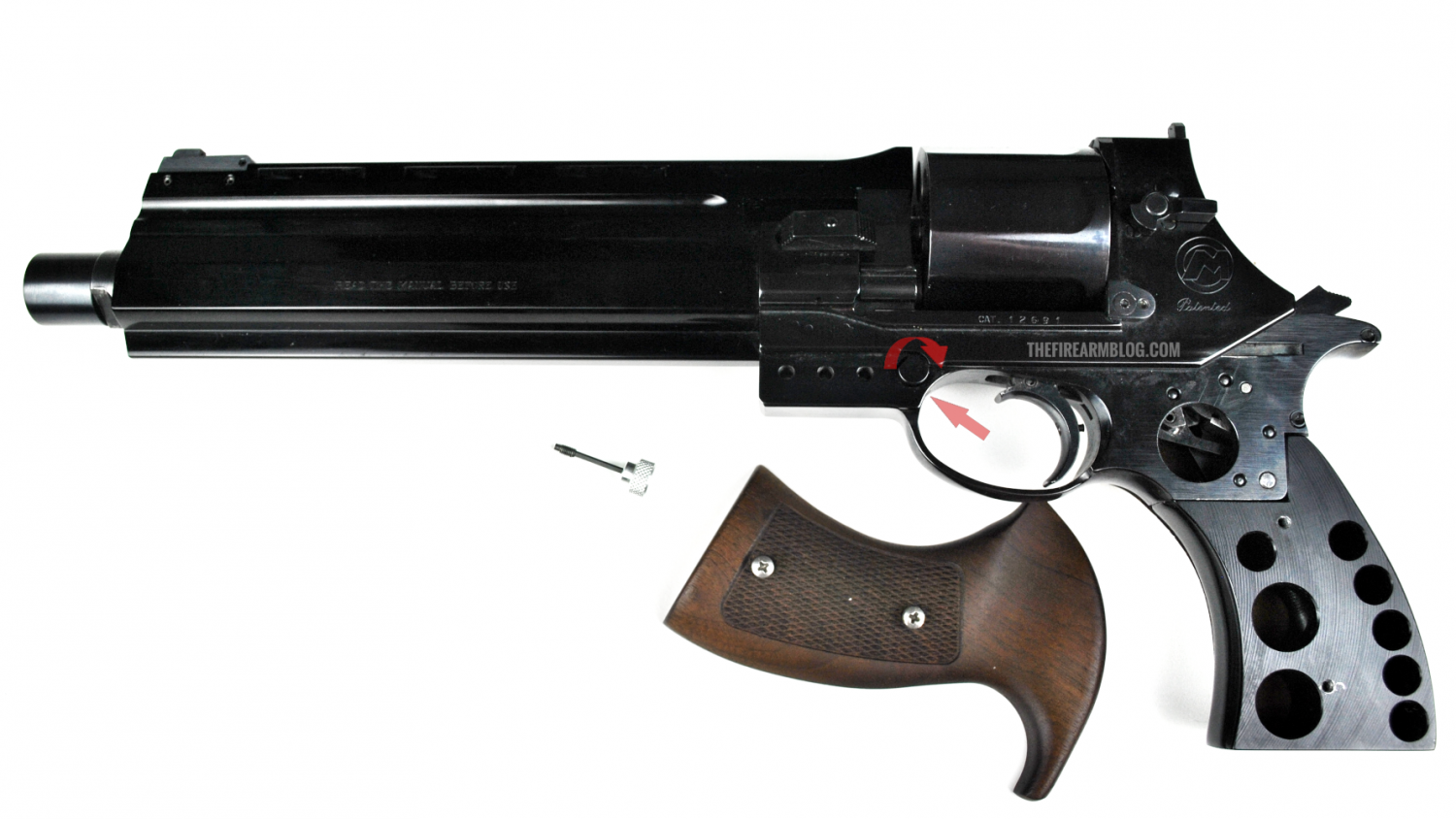
MATEBA Autorevolver 6 Unica cal. .454 Casull – Field Strip Step 1 – Using the provided Allen key, pictured, remove the grub screw (62) accessible through the trigger guard, as indicated by the arrow. The screw will stay safely on the tip of the key. Now, from the right side of the frame, manually rotate the slide stop pin (29) until the flat face is horizontal. Now the pin can be slid out. Cocking the hammer can be done in the beginning to have more room in the trigger guard.
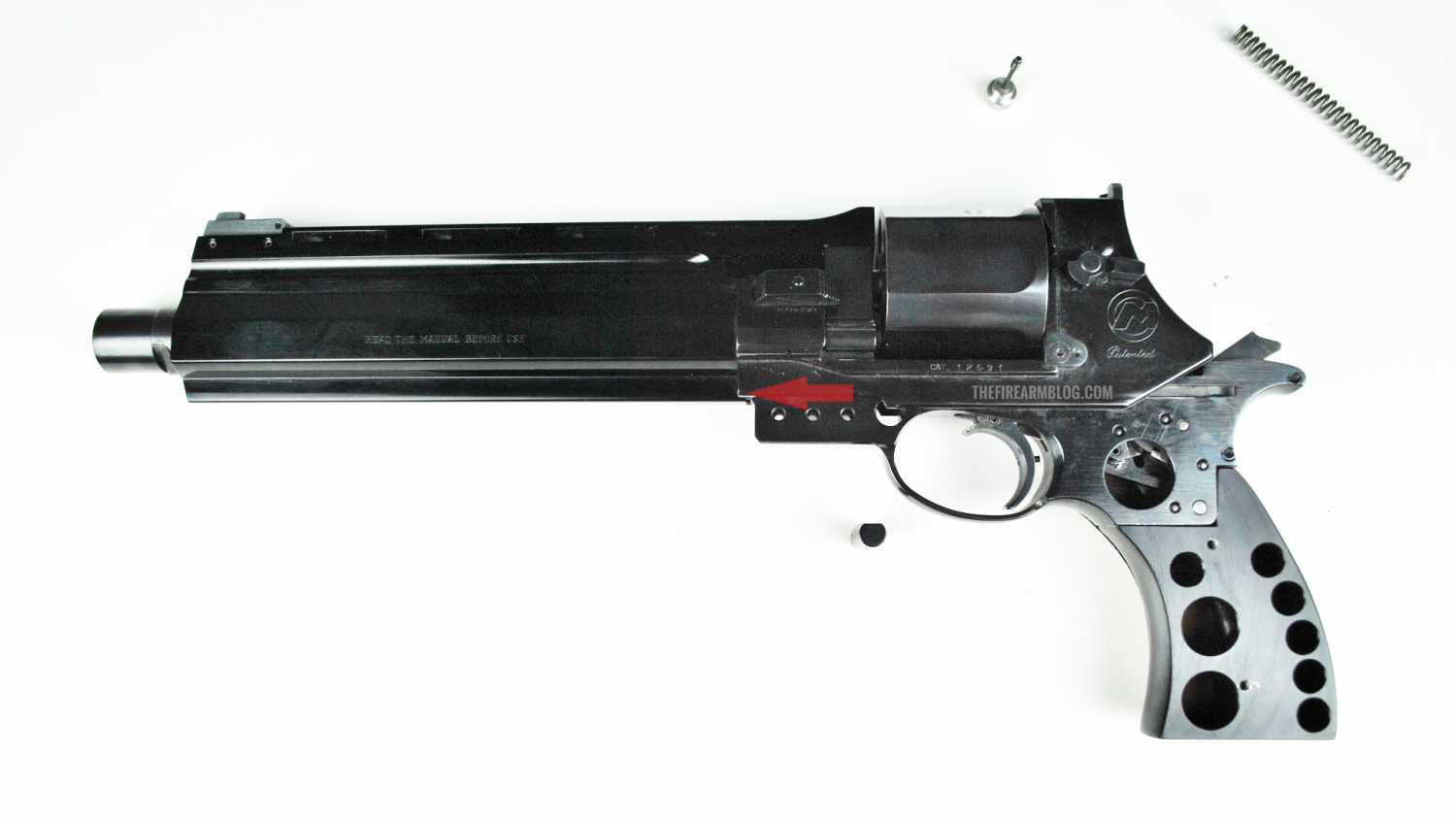
MATEBA Autorevolver 6 Unica cal. .454 Casull – Field Strip Step 2 – After removal of the slide stop pin, the slide can be moved forward. To allow the slide to move freely, the hammer must be cocked, this allows the pin of the desmo to clear the rail of the distributor.
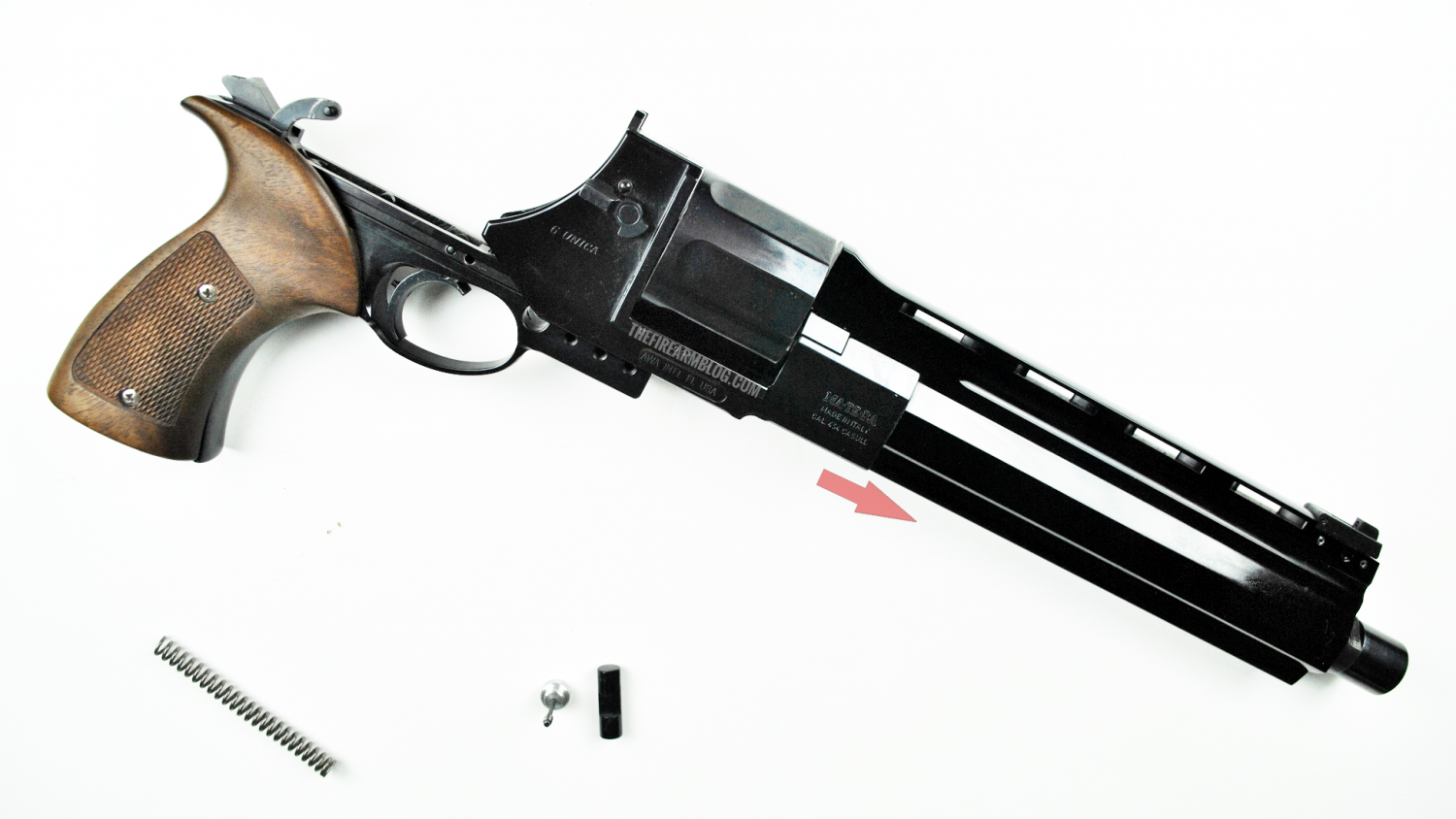
MATEBA Autorevolver 6 Unica cal. .454 Casull – Field Strip Step 3 – Continue moving forward the slide until the rails disengage. Pay attention to the recoil spring as it will pop out.
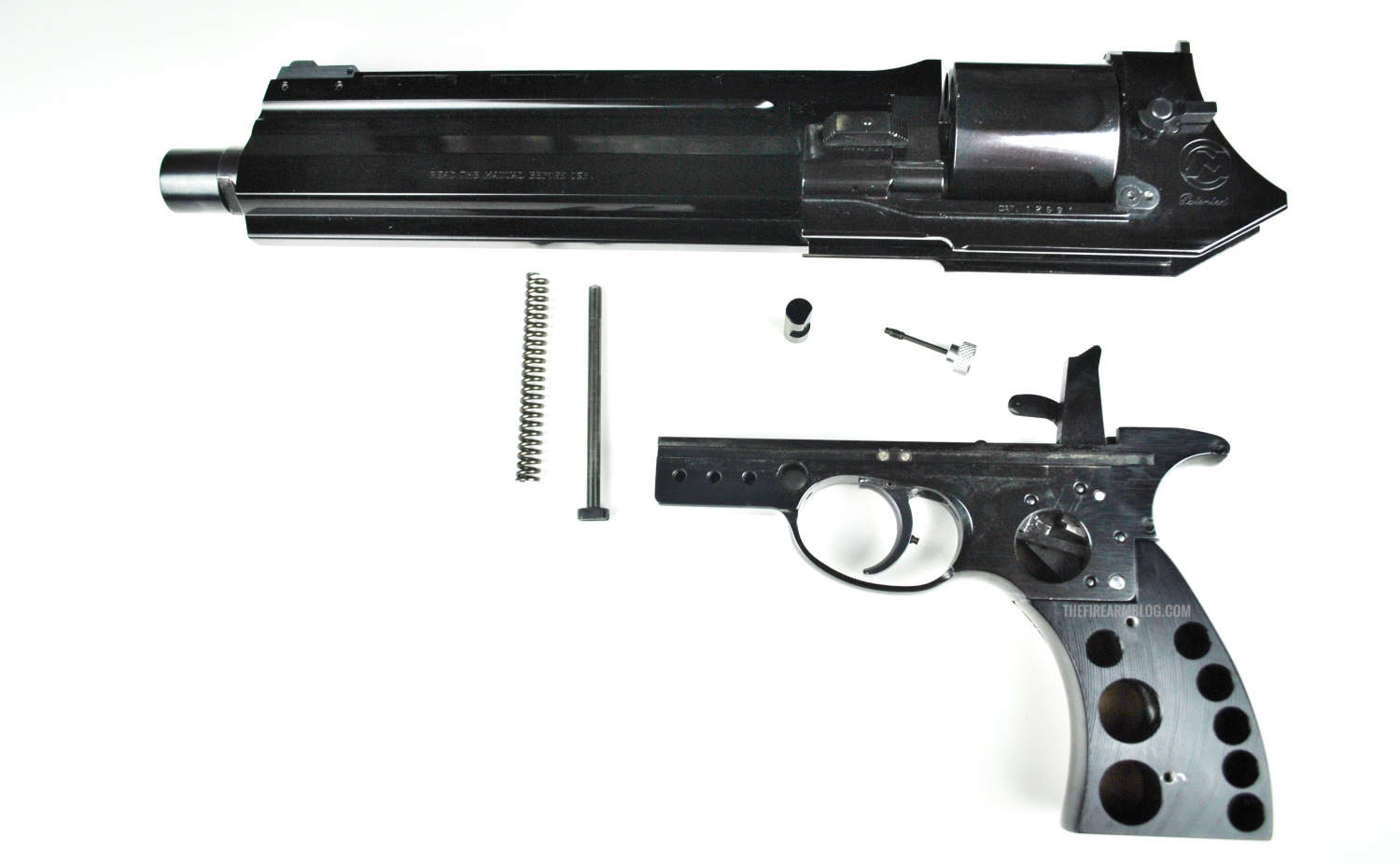
MATEBA Autorevolver 6 Unica cal. .454 Casull – Field Strip Step 4 – Main components separated. Now the spring (27) and its guide rod (26) are accessible and the spring can be replaced as needed. Reassembly can happen by doing these steps backwards, we’ll see below an important detail, however. When dealing with the spring strength of .454 Casull, a vise can be helpful to allow safe and curse-free reassembly.
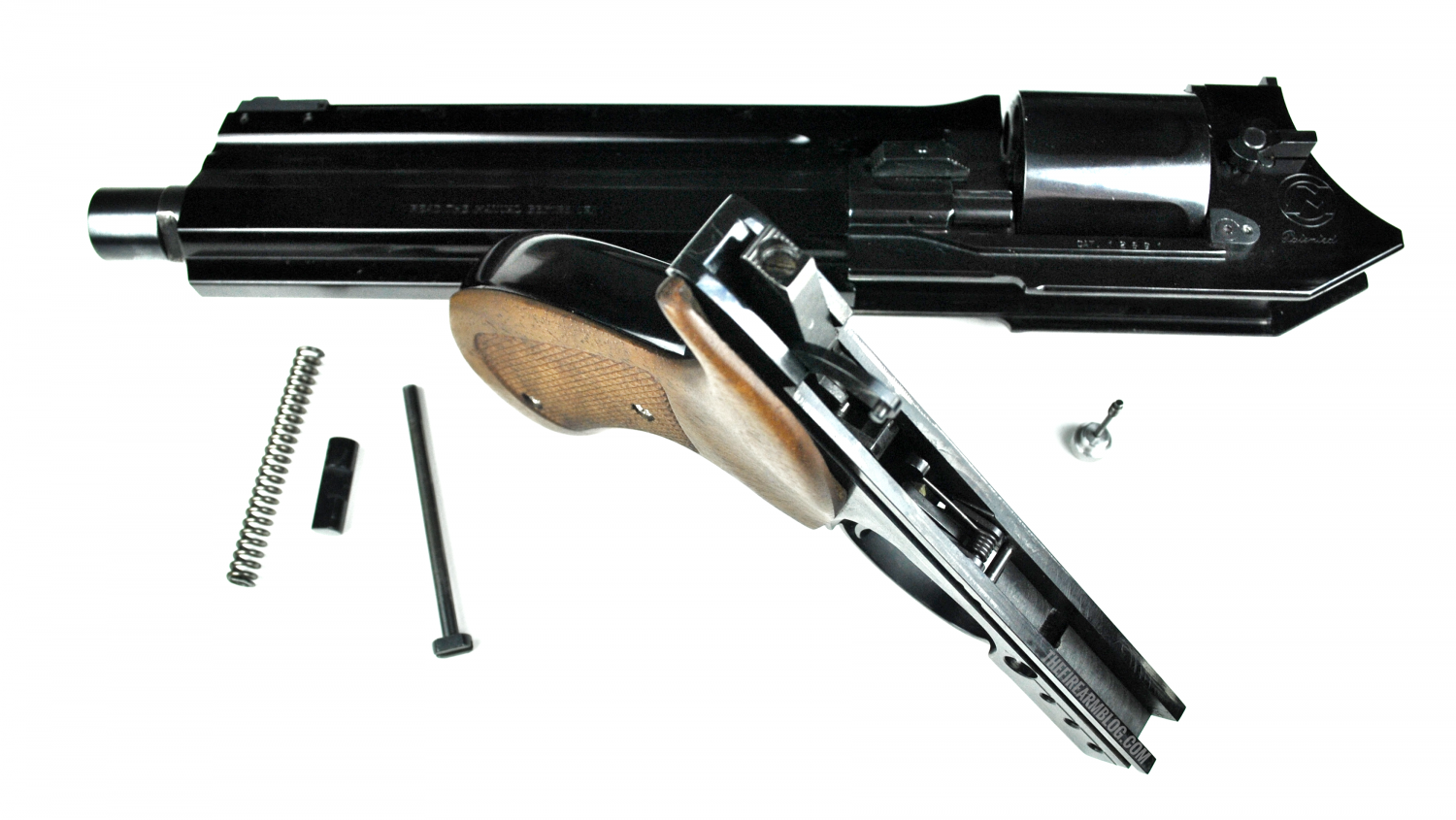
MATEBA Autorevolver 6 Unica cal. .454 Casull – Field Strip – View of the action in the lower frame.
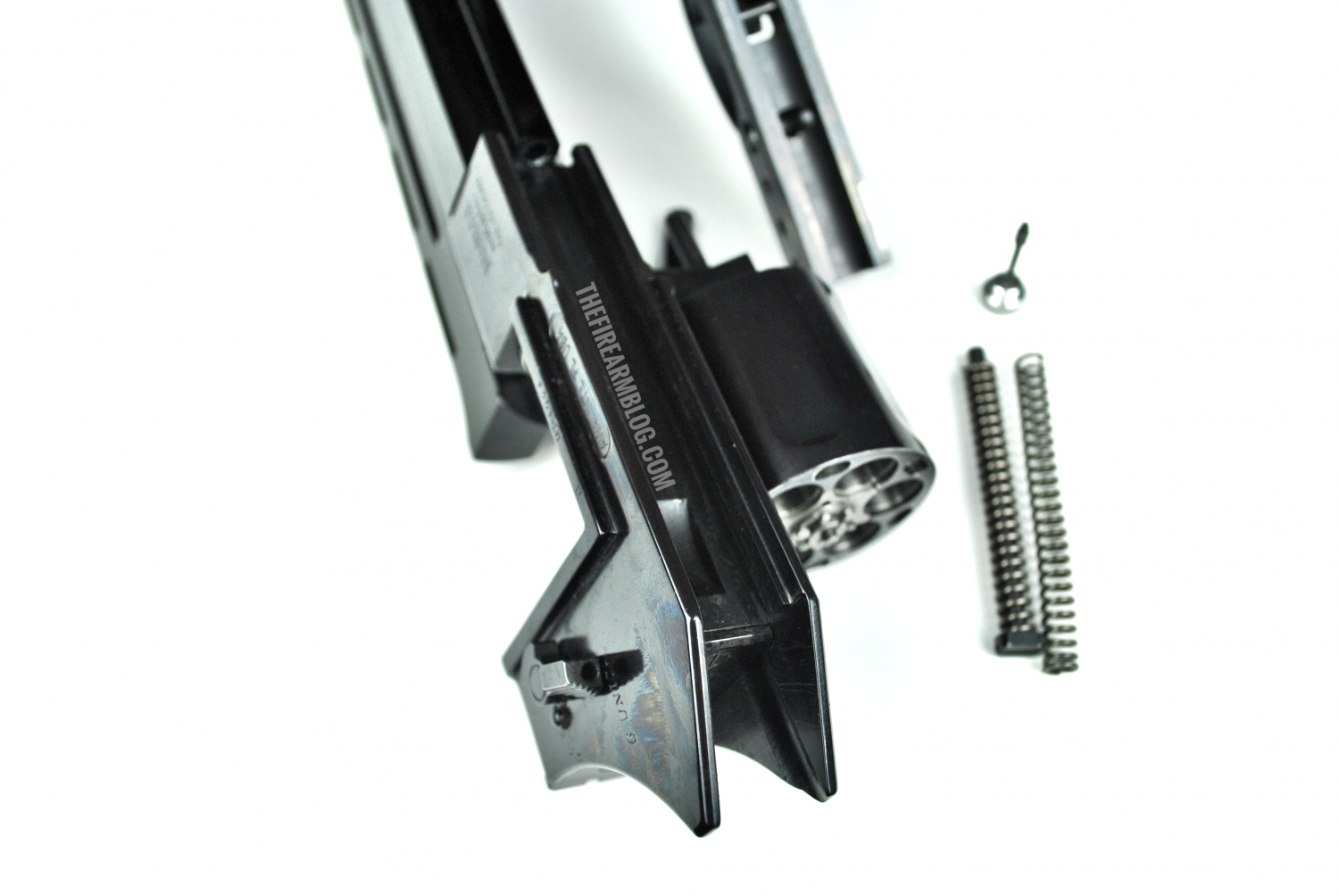
MATEBA Autorevolver 6 Unica cal. .454 Casull – Field Strip – View of the bottom of the slide with full-length rails. In the background, .454 Casull spring on the guide rod and longer, thinner, .45 Colt on its right.
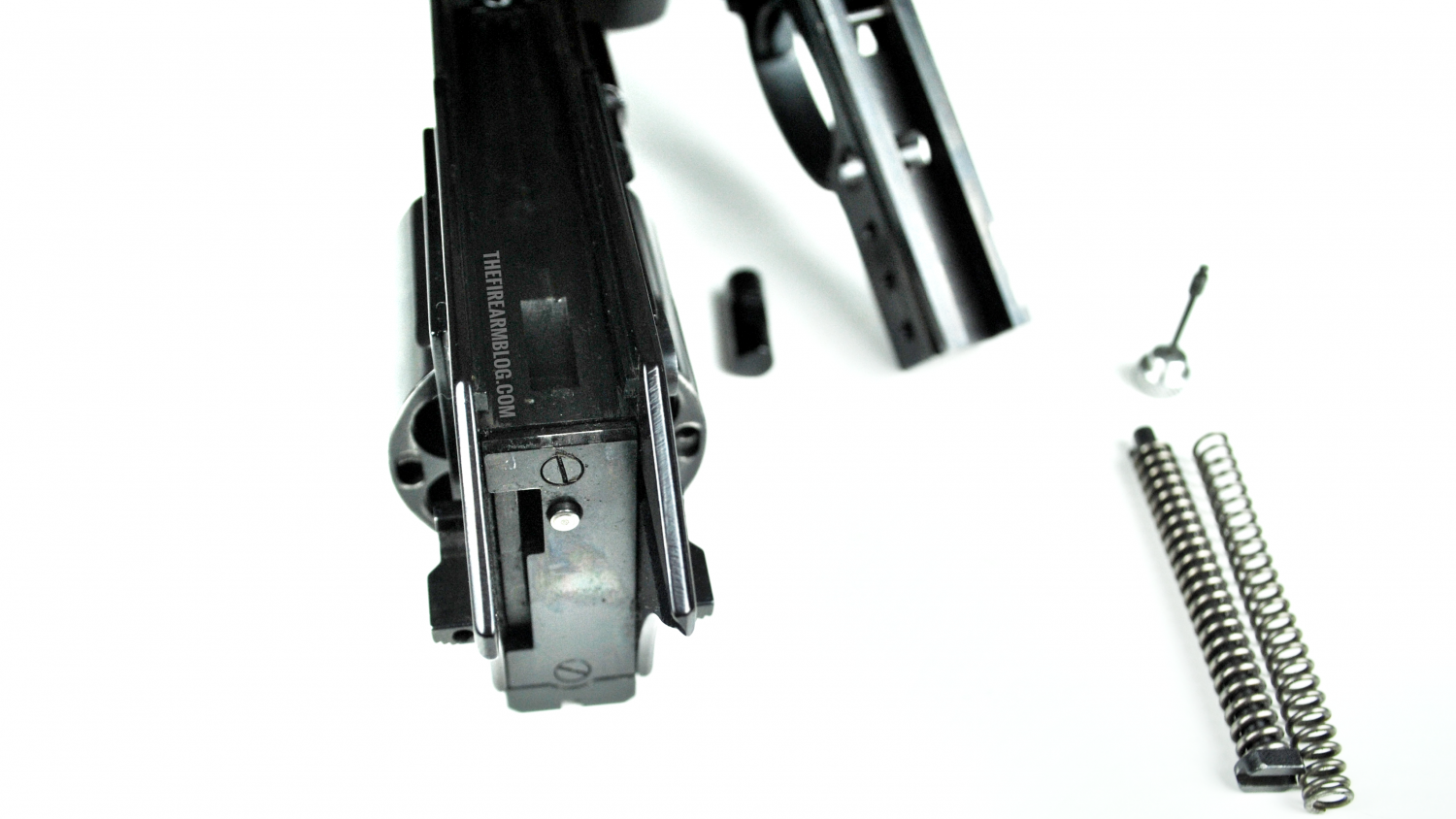
MATEBA Autorevolver 6 Unica cal. .454 Casull – Field Strip – Note the slide distributor fully hiding within the back of the frame.
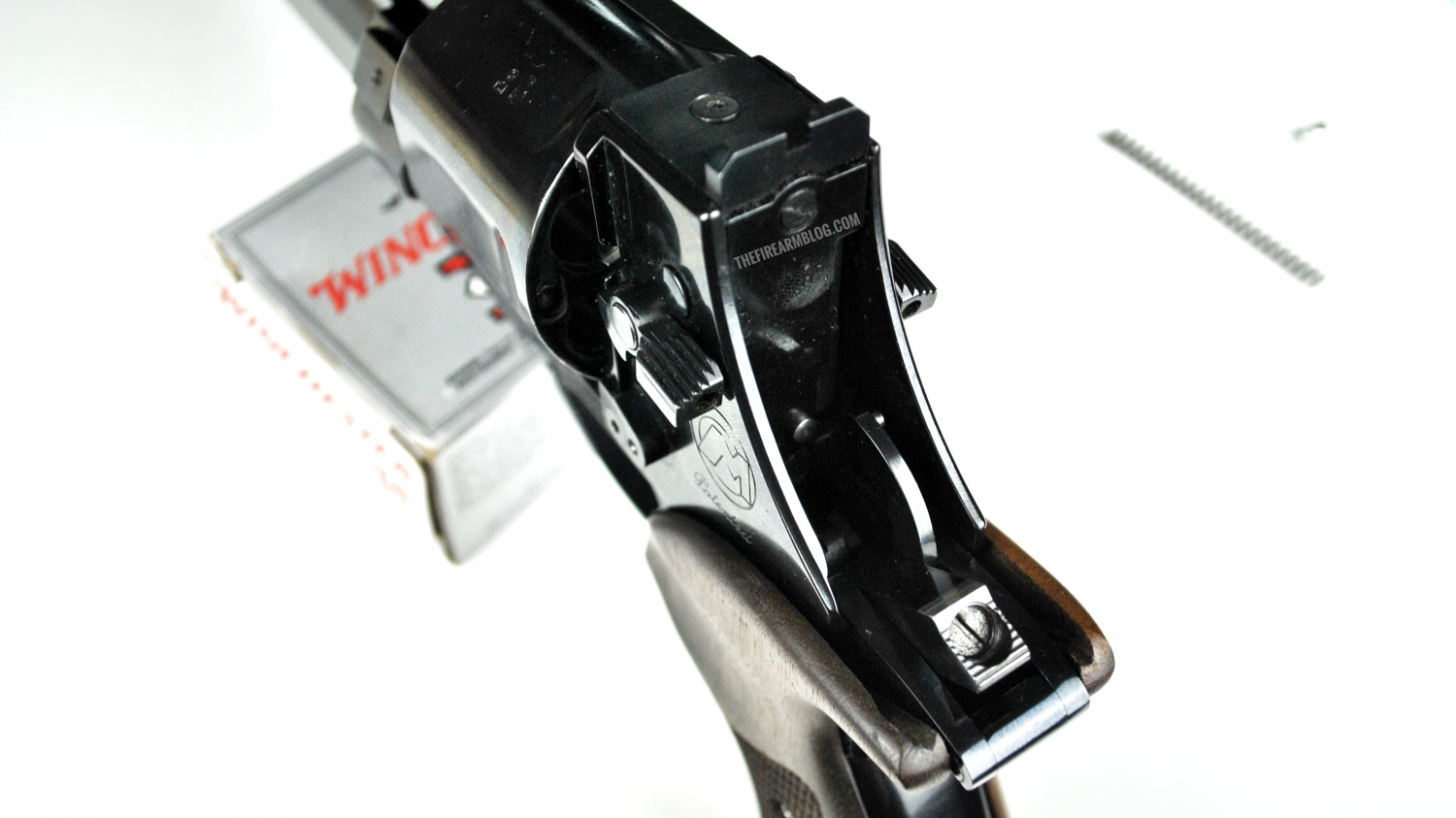
MATEBA Autorevolver 6 Unica cal. .454 Casull – Field Strip – Reassembly without pulling the distributor out of the frame and allowing it to engage with the desmo will result in the two being disconnected, preventing proper operation.
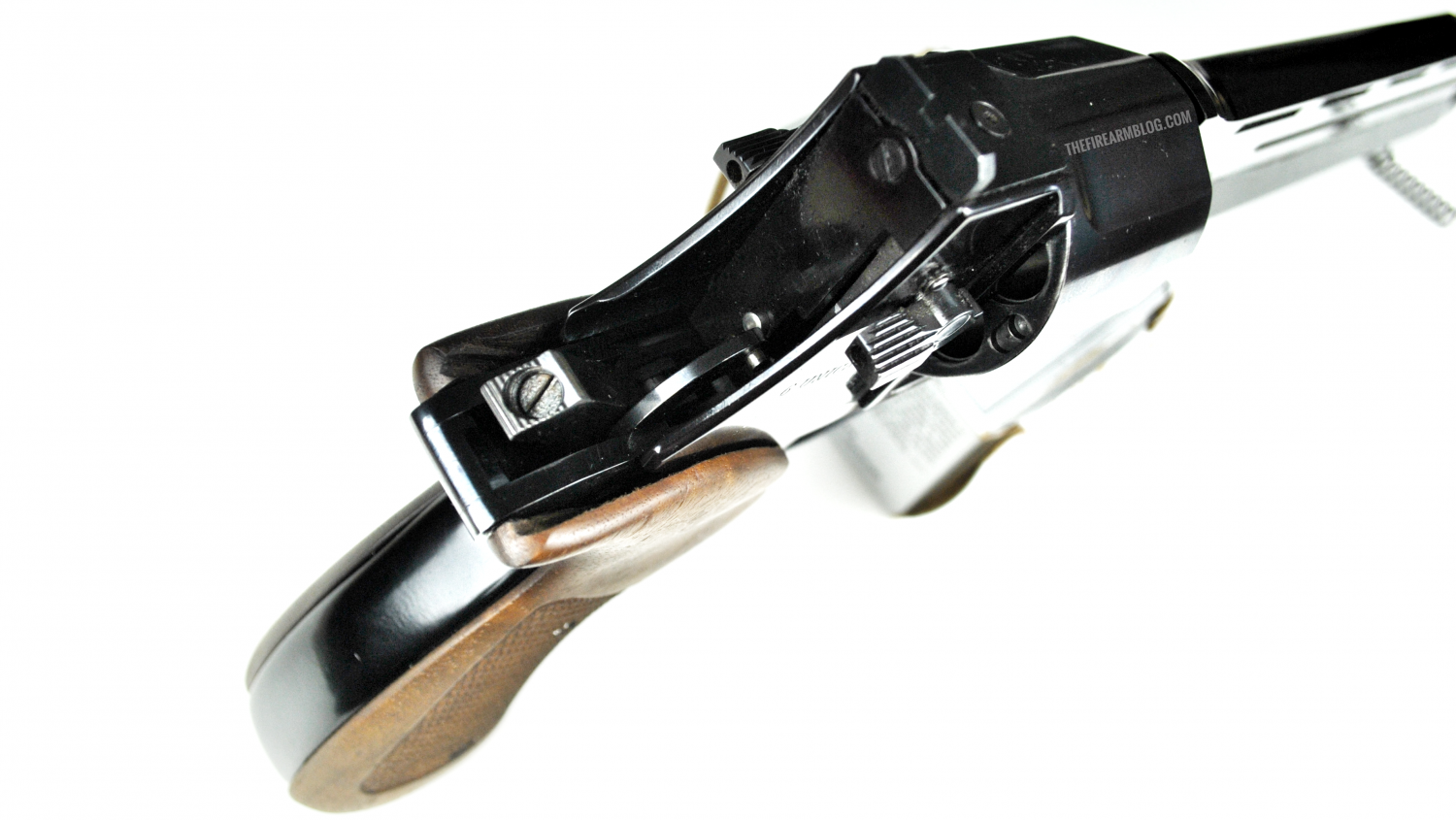
MATEBA Autorevolver 6 Unica cal. .454 Casull – Field Strip – Another view of the action with the desmo not reaching the distributor. If facing this situation, the slide stop pin must be removed again to allow the slide to move forward. The distributor can then be pulled out fairly easily with a small hook, for example from a bent paper clip. Once the pin on the desmo rides within the fork, the slide can be pulled back fully and the stop pin put back in place.
7. MATEBA Autorevolver 6 Unica cal. .454 Casull – Range Feedback
I do not have any recent experience or targets to share, but this pistol was bought for shooting so I can offer insight on a few points.
- Handling
It’s a huge, heavy and cumbersome piece of metal. This does not help in keeping the sights on target, however, it makes shooting .454 Casull a pleasant experience. The Mateba Autorevolver overall offers a feel of quality and mechanical accuracy which is confirmed by trying to shake the slide on the grip frame. The two parts move together as a single piece with very little play.
- Trigger Pull
Unfortunately, I had no means to measure the actual trigger pull weight, however, I have some data and considerations to share. First of all the manual mentions the following:
-Single Action: 1.5 kg (3.3 lbs)
-Double Action: at least 5.0 kg (11.0 lbs)
I underlined the “at least” part as the manual is general and covers all models. Since the DA pull rotates the cylinder, I expect the .357 model pull to be lighter than the bigger calibers with heavier cylinders. Moreover, the leverages designed for the components of the .357 may be less ideal for bigger parts. As a result, the DA pull in the .454 sucks!
It is extremely heavy and it has a tendency to lock up if the pull isn’t consistent and smooth. Shooters can train themselves to pull it properly but, together with the fairly big grip, managing accurate DA shooting with this trigger would be challenging at the very least. The feel is that, given that the majority of shots will be fired in SA, not much thought was given to offer a nice double action. The screw on the top of the hammer may be there to allow pull weight adjustments, however, this is not covered in the manual, so any attempt to act on it should be approached carefully.
The SA pull, conversely, is top notch! Besides its weight, it feels great for its consistency, short travel and sharp release. The take-up is really short and there is no perceptible creep, just a clean break. The overtravel is minimal and it can be adjusted to one’s taste by acting on the grub screw within the trigger. Overall this is a great target shooting set up. To give a better idea of how the action works, you can look at the photo below.
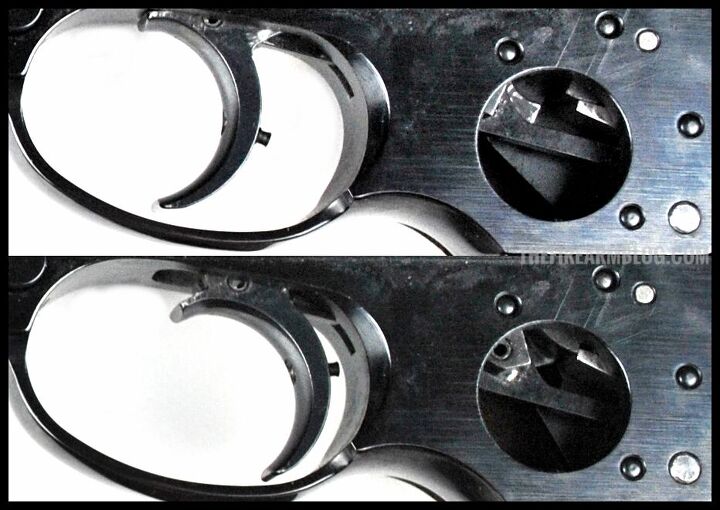
MATEBA Autorevolver 6 Unica cal. .454 Casull – Top DA and bottom SA. Look at the circle on the right, in the quarter between 12 and 3 o’clock you can see the hammer and the sear interacting. The sear appears in the white, while the hammer is blued. The SA photo is a good indication of the trigger pull features. Note the short travel available for the trigger and the minimal engagement surface between hammer and sear.
- Springs
When you buy a .454 Casull revolver and you want to take it to the range quite a few times for informal target shooting, you may want to shoot .45 Colt loads. They are less demanding, both power wise and economically. However, the Mateba Autorevolver is not a common .454 revolver. The huge performance gap between standard “cowboy loads” .45 Colt and the full power Casull means that a different recoil spring is required.
Unfortunately Mateba thought about this need for .38 Special and .44 Special, but not for .45 Colt. The spring I ended up using, after various shipments, experiments and phone calls, was a chopped .44 Magnum spring. With that one, I reached about 90% reliability over a few hundred .45 Colt shots.
If the load is too weak to cycle the action the slide may lock rearward. To solve this, keeping the thumb on the hammer spur, one must press the muzzle against a hard, stable, surface until the slide unlocks and comes back forward. Range officers love it…
Shooting .454 Casull with the factory installed spring yielded 100% reliability.
- Range Anecdotes
Unlike the Webley-Fosbery, the action of the Mateba Autorevolver feels faster than (or just as fast as) a traditional semiauto pistol. Moreover, thanks to the low barrel and heavy weight, its muzzle flip is really limited and the recoil easily manageable (with or without compensator). Side by side with a .45 ACP 1911 the .454 Casull Autorevolver shows less muzzle rise and a smoother push back.
On the quickness of the cycle, coupled with the features of the single action discussed above, I have an entertaining range story.
I once went to the range with a good friend. While he loves revolvers and beautiful things, he more frequently shoots a Glock (no, he’s not Pete) and he trains himself to double tap efficiently. It was his first time to see my Mateba Autorevolver and I handed it to him with a full cylinder of .454 Casull, 300 grs Winchester JFP. He took aim, squeezed the trigger and BOOM! a much louder report than I was used to. I saw him grimacing while he lowered the revolver, I quickly picked it up fearing a ka-boom. Everything was in its place, I lowered the hammer and opened the cylinder: 3 primers were struck. In disbelief, I ejected the cases finding 3 of them empty. He had accidentally bump fired a .454 revolver. A total of 900 grains shot at about 1625 fps is just 200 fps short of what .600 Nitro Express offers from a rifle barrel! Neither of us felt that more than one shot was fired, all happened in a fraction of second. My friend ended up with a cut on a knuckle of his left hand, caused by his finger hitting the cylinder opening lever under recoil. He chose not to fire the remaining rounds…
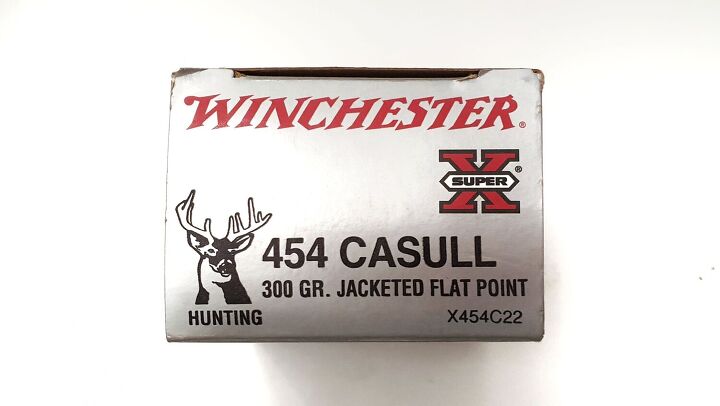
MATEBA Autorevolver 6 Unica cal. .454 Casull – Winchester load as the one that was shot in the 3 rounds burst. It now seems to be discontinued.
Regarding accuracy, I can only attest that the platform is much better than this shooter. In more capable hands I saw the Autorevolver being able to place all shots in a couple of inches or so at 25 meters.
8. MATEBA Autorevolver 6 Unica cal. .454 Casull – Pros & CONS
- PROS
-Cool and unique
-Mechanically interesting
-Accurate execution and attention to details
-Powerful and easy to control
-Always a conversation piece and now a collector’s piece
- CONS
-Limited practical value
-Answers questions never asked
-Poor Double Action trigger
-Front latch requiring manual closure is a poor design choice
-Expensive
-No aftermarket support
9. MATEBA Autorevolver 6 Unica cal. .454 Casull – Final Considerations
I think it’s pretty clear that I like this piece. It has its flaws and maybe it has no rational reason to exist, but I’m happy it does. Just like some Italian sports cars, it may not be perfect, but who wants to puts up with their “character” will fall in love.
I think it’s a shame that the Mateba Autorevolver did not have more success, but maybe it was its destiny to be an icon in the same world of the Wildeys and Automags. Peculiar designs with limited practical value and a lot of cool features.
Now it seems that the new Mateba is actually putting some effort in reviving the model and we can cross our fingers and wait. If they had the resources and the will (=some market interest) I believe there would be the potential for some minor re-design to offer a truly modular revolver. Looking at the handgun diagram, all the parts of the lower are common to all configurations. Having this part serialized as “the firearm” would allow even more modularity than the awesome Janz revolver, while at the same time offering the very familiar upper-lower approach. Well, one can dream.
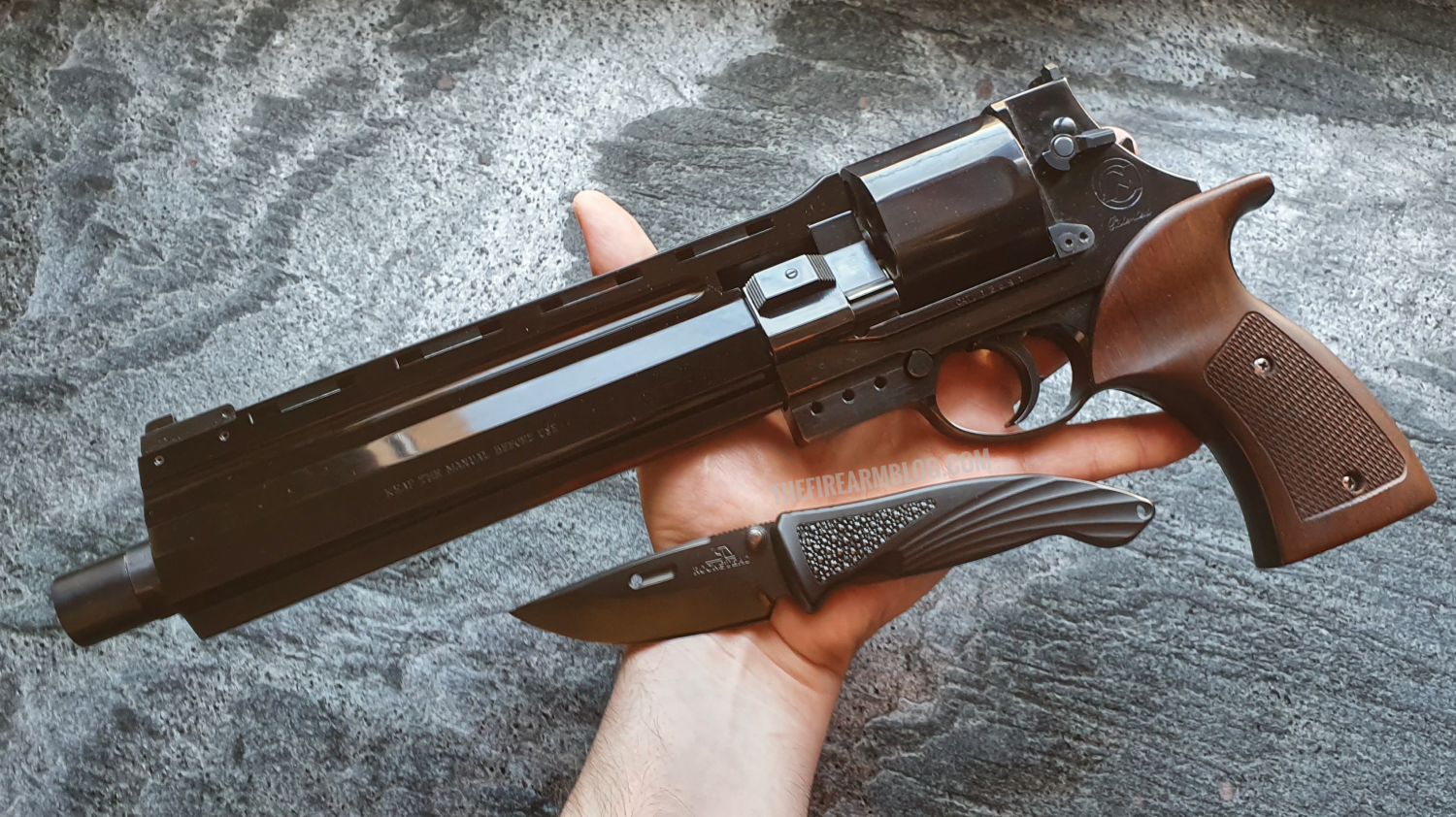
MATEBA Autorevolver 6 Unica cal. .454 Casull – Tribute to fridgeoperator. My hands aren’t small but with this cannon, it’s quite challenging to balance everything. I forgot to lock the front latch, not a problem now, but it can happen every time the cylinder is loaded. The knife is a Rockstead KOU DLC.
10. MATEBA Autorevolver 6 Unica cal. .454 Casull – TL-DR
A unique revolver with a semiautomatic operation, the Mateba Autorevolver is on a class of its own. In .454 it’s a bulky beast which can be a hunter’s tool or a fun range piece. It can have its place as a collector’s safe queen, but it’s a good shooter that makes shooting the .454 an enjoyable experience… unless you bump fire it, that’s it.
 Your Privacy Choices
Your Privacy Choices
